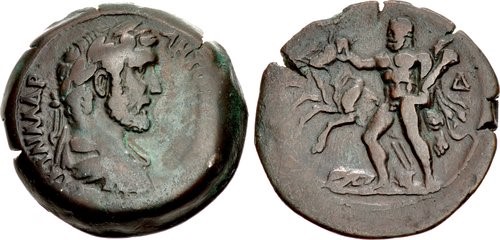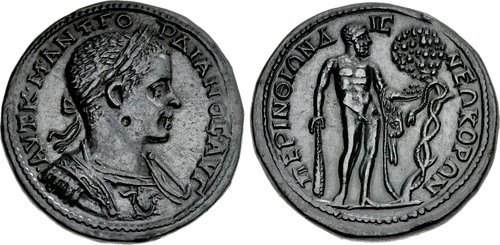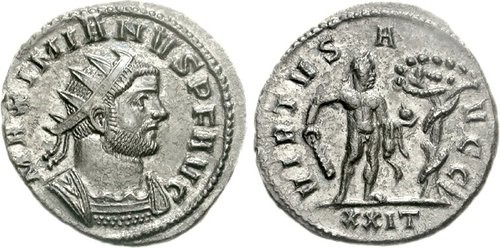NGC Ancients: The Twelve Labors of Hercules ‒ Part Two
Posted on 2/8/2022
By
Ben Wallace
NGC Ancients Grader
In last month's column, we covered the first half of the Labors of Hercules. They were some of the greatest adventures undertaken by the mythological hero. This month, we’ll cover the remaining six labors that he completed for King Eurystheus. During these final quests, Eurystheus was angry that Hercules hadn’t yet been killed, so he came up with tasks of increasing difficulty.
Seventh Labor: Capturing the Cretan Bull
Hercules' next task was to capture the Cretan bull. This animal had been wreaking havoc on the island of Crete for many years and was the father of the famed Minotaur. When Hercules arrived in Crete, he had little difficulty capturing the beast. He strangled it until it passed out, then he shipped the bull to king Eurystheus in Greece.
Eurystheus wanted to sacrifice the bull to the chief Greek goddess Hera, but she declined. The king released it, and it wandered near the city of Marathon, where it continued to cause destruction. Eventually, the mythological hero Theseus captured and sacrificed the bull.
 |
This labor is illustrated on the 28mm bronze above from the city of Nicopolis in Moesia. It was struck during the reign of the Roman emperor Septimius Severus (A.D. 193-211). The reverse shows Hercules grabbing the head of the Cretan bull. Two accoutrements of Hercules — a bow and a club — appear below.
 |
A second example illustrating this labor, above, was minted during the reign of the emperor Gordian III (A.D. 238-244) at the Thracian city of Hadrianopolis.
Eighth Labor: Capturing the Mares of Diomedes
While there are a few versions of this story, all share common features. For this task, king Eurystheus sent Hercules to capture the mares of the Bistonian king Diomedes. These mares were fed human flesh and were vicious. Hercules took with him a small group of men for aid. In all of the accounts, Hercules defeats Diomedes along with all of the king’s men. Once Diomedes was defeated, Hercules fed him to his own mares. This calmed the animals enough for Hercules to tie their mouths shut and bring them to king Eurystheus.
 |
The bronze drachm above was made in A.D. 142/3 under emperor Antoninius Pius (A.D. 138-161) in the Egyptian city of Alexandria. Due to die shift on the reverse some details are weak, but we can still make out most of the image. Hercules brandishes his club over the head of a galloping mare as we see another fallen mare behind Hercules’ legs. King Diomedes can be seen lying on the ground.
Nineth Labor: Capturing the Belt of Hippolyta
Hercules’ next task was to retrieve the belt of the Amazonian queen Hippolyta for King Eurystheus’ daughter. The belt had been a gift from the war-god Ares, who was Hippolyta’s father.
Hercules set out with a group of companions to the home of the Amazons. Once there, he explained his mission to Hippolyta, and she agreed to give him the belt. However, the goddess Hera, wanting the hero to fail, went to the Amazon warriors and tricked them into attacking Hercules. Seeing the warriors preparing to fight, Hercules slew Hippolyta and took the belt.
 |
Made in A.D. 141/2, during the reign of Antoninius Pius, the coin above is one of the finest known Alexandrian drachms illustrating this labor. On the reverse Hercules reaches towards the belt on the fallen Hippolyte, who is seen lying across the top of her horse.
 |
The emperor Gordian III is seen in military attire on the obverse of this 40mm bronze from the Thracian city of Anchialus. The reverse shows Hercules raising his club to strike Hippolyte, with the queen trying to extract her hair from Hercules' grip before the blow comes.
Tenth Labor: Capturing the Cattle of Geryon
For the next task, Hercules had to capture the cattle of the three-bodied giant, Geryon. In this adventure our hero travels to the edge of the world, thought to be near the Strait of Gibraltar. Once there, Hercules fought and killed the two protectors of the flock, a herdsman and two-headed dog. Hearing the commotion, Geryon joined in the fight and was killed with a poison arrow shot by Hercules.
Once Hercules had the cattle, he journeyed back to King Eurystheus, who sacrificed the animals to Hera.
 |
The bronze drachm above from A.D. 140/1 was made in Alexandria under Antoninus Pius. On the reverse, Hercules grasps the horn of a leaping bull with the body of Geryon under his feet. Another bull, not yet captured, leaps behind.
 |
The 32mm bronze above, from Perinthus in Thrace, is in rough condition. Minted under the emperor Gallienus (A.D. 253-268), the reverse shows Hercules brandishing his club and driving the Geryon cattle before him.
Eleventh Labor: Collecting the Golden Apples of the Hesperides
By this point, King Eurystheus was especially angered that Hercules had accomplished all he’d asked. The king’s next task was meant to anger the gods and bring their wrath upon Hercules. The hero needed to steal three golden apples from the garden of the nymphs Hesperides.
To do this, Hercules needed to trick the nymphs. He went to the nymphs’ father, Atlas, a titan condemned to hold the weight of the earth for eternity. Hercules offered to hold the earth for Atlas if he would get the apples. Atlas agreed and our hero held the weight of the world until Atlas returned. However, after being freed, Atlas did not keep his end of the bargain and instead planned on delivering the apples himself, leaving Hercules to hold the world. Hercules, however, tricked Atlas into taking the world back, after which he delivered the apples to Eurystheus himself.
In another telling of this story, Hercules goes to collect the apples and slays the dragon, Ladon, who was protecting the garden. This is the story more often portrayed on Roman coins — including the two below.
 |
The 39mm bronze above, made in Perinthus under Gordian III, offers an excellent rendering of the story. Hercules, leaning on his club, holds a pile of apples under a tree. The defeated Ladon is shown coiled around the trunk.
 |
Made during the reign of the emperor Maximian (A.D. 286-305), the billon aurelianianus above shows the same scene. Hercules holds a single golden apple plucked from the tree before him. The dragon can be seen encircling the tree and seems to be lunging at Hercules. Our hero lifts his club, apparently to defend himself from the monster.
Twelfth Labor: The Capture of Cerberus
The final labor king Eurystheus demanded of Hercules was to capture Cerberus, the three-headed, dragon-tailed dog who protected the entrance to the underworld. No mortal had ever returned from the underworld and Eurystheus was sure Hercules would perish in the attempt.
To prepare himself, Hercules was initiated into the Eleusinian Mysteries, sacred rites to help one's soul in the afterlife. Once he’d accomplished this, Hercules entered the underworld. He sought the god Hades and asked for permission to take Cerberus. Hades agreed, but only if Hercules could capture Cerberus without weapons. Thus, the weaponless Hercules fought Cerberus and subdued him. He then brought Cerberus to Eurystheus, who released the beast so it could return to the underworld.
 |
Made in the Thracian city of Hadrianopolis under Gordian III, this 27mm bronze has a detailed depiction of Hercules on the reverse. Our hero holds his club, with the lion pelt billowing behind. To the right are the three heads of Cerberus.
 |
We’ll end our survey with this beautiful gold aureus made during the reign of the emperor Probus (A.D. 276-282), who on the obverse is shown in full military attire. On the reverse, Hercules is seen leading Cerberus out of the underworld on a leash.
All photos courtesy of Classical Numismatic Group.
Interested in reading more articles on Ancient coins? Click here.
Stay Informed
Want news like this delivered to your inbox once a month? Subscribe to the free NGC eNewsletter today!
